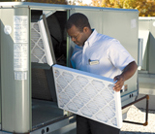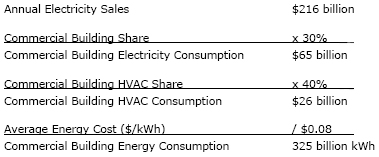
AIR FILTERS AND ENERGY
HVAC filters play a key role in the HVAC system: they remove contaminants from air that passes through the system to building occupants, and they protect the HVAC equipment from dust. Filters also play a significant role in the energy consumed to operate the system. The energy used by HVAC systems is based on the resistance of the air passing through the filter; the lower the filter’s resistance, the lower the energy consumption will be. However, even though one speaks of filters, it is really thefilter mediathat has the biggest effect on minimizing energy consumption.To look at HVAC filters as energy conservation tools, it’s first important to understand that the cost of energy used by filters far outweighs the cost of the filter itself. In fact, energy costs can be 10 times the initial filter cost for a standard pleated filter and four to five times the initial filter cost for higher efficiency final filters.

LIFE CYCLE COSTS
Life cycle costs, energy costs, and a filter’s resistance to airflow should all come into play during the filter selection process. The three major components of life cycle cost for HVAC filters are: initial investment and maintenance, energy consumption, and disposal.On average, energy cost accounts for an astounding 81 percent of the total life cycle cost of a filter system.The initial investment and maintenance accounts for 18 percent, and disposal accounts for 1 percent. The chart here illustrates these costs for two different filters.
Switching to a filter with a lower resistance to airflow is one of the easiest changes for building owners and facility managers to make in an effort to reduce energy costs.That’s because, with a lower resistance to airflow, the HVAC system motor needs to work less to deliver the required airflow, thus reducing the motor’s energy consumption.

Filter A provides a lower initial and average airflow resistance and therefore saves approximately $29 in energy costs annually - about a 10 percent reduction in energy consumption. While an energy cost savings of $29 per year may not sound like a lot, keep in mind that those cost savings are per filter, not for an entire HVAC system. Multi-story office buildings can contain many filters per AHU, so savings can quickly add up. Another way to look at the information is to consider that $29 saved with Filter A offsets 41 percent of the initial filter price. That’s equivalent to nearly getting half of your filters free each year.

THE MACROSCALE EFFECT
From a macroscale standpoint, the overall effect of energy consumed by commercial building HVAC systems can be estimated by considering that commercial buildings account for just over 30 percent of the energy consumption in the U.S., and that heating and cooling accounts for 40 percent of a commercial building’s total electricity bill. This is illustrated by the following:The effect of a change in filter airflow resistance on total energy consumption can be estimated by assuming that the average airflow resistance in every commercial building filter is reduced by 0.025 inches wg. Assume it changes from 0.700 inches wg to 0.675 inches wg in this example. By applying a simple ratio to the energy formula, the total energy used in the reduced airflow resistance scenario is 313 billion kWh, resulting in a 12 billion kWh energy savings. At an energy cost of $0.08/kWh, this translates into cost savings of $960 million.
ASK YOUR FILTER SUPPLIER
Most building owners and facility managers would agree that filtration efficiency comes first. Beyond the MERV or efficiency rating, buyers and specifiers often use filter price as the next decision-making criteria. However, after examining life cycle cost and energy saving opportunities, it is evident that the key criterion should be energy consumption, as indicated by the initial airflow resistance of the filter. When considering the energy costs of various filter technologies, ask your filter supplier the following questions:• At a given performance level, how much money could be saved by using a filter with a lower airflow resistance?
• What airflow resistance reduction offsets the difference in initial filter price?
• How much of my initial filter costs does that energy cost savings offset?
Focusing on total life cycle costs versus initial price and maximizing filtration efficiency while minimizing airflow resistance will allow you to reap the largest value and will help you achieve good IAQ, reduced equipment maintenance, and the lowest possible energy costs.
To see how the energy consumption of your HVAC filters compares with other filters, try the interactive online calculator at www.kcfiltration.com.
Reprinted with permission from the Kimberly-Clark Filtration Products publicationFiltering Out Confusion – A Guide to Reducing HVAC Energy Costs.For more information on HVAC filter technology, visit www.kcfiltration.com.
Publication date:06/09/2008

Report Abusive Comment